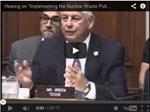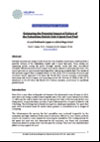Power company, opponents clash over Comanche Peak expansion
April 15, 2010
By JACK Z. SMITH
Fort Worth Star-Telegram
GRANBURY — Luminant, the power generator proposing a multibillion-dollar expansion of the Comanche Peak nuclear power plant, took issue Thursday with arguments that it failed to give sufficient consideration to renewable energy alternatives and catastrophic radiation leaks that might result from an event such as a terrorist attack.
The issues were debated by lawyers for Luminant and plant opponents at a hearing held in Granbury by a three-judge panel of the federal Atomic Safety and Licensing Board. The hearing is part of Luminant’s application for a license to expand Comanche Peak from two to four reactors. The plant is near Glen Rose, 45 miles southwest of Fort Worth.
The panel is expected to decide, perhaps within two months, whether Luminant’s environmental report on the proposed expansion gives adequate consideration to alternatives to nuclear power and to safety risks posed by building reactors near the existing ones, which went online in the early 1990s.
Luminant attorney Steven Frantz said renewable energy options, such as a combination of wind and solar energy supplemented by natural-gas-fired generation and a compressed-air energy storage system, wouldn’t meet the need for a "baseload" power plant that could reliably generate large volumes of electricity around the clock.
"There are no combined wind and solar facilities anywhere in the world that provide baseload power," Frantz said. "It’s never been done."
Robert Eye, an attorney for opponents of the nuclear expansion, argued that the technology for wind and solar power is "advancing on an almost daily basis."
Frantz said amendments to Luminant’s environmental report adequately address concerns about the ability of Comanche Peak to contain radiation leaks. But Eye countered that Luminant failed to sufficiently consider the possibility that substantial radiation could be emitted by spent nuclear fuel if there were an accident.
Plant opponents, dubbed "intervenors" in the licensing process, are the Sustainable Energy and Economic Development Coalition, Public Citizen, True Cost of Nukes and state Rep. Lon Burnam, D-Fort Worth.
Attorneys for the Nuclear Regulatory Commission, which licenses new reactors, often sided with Luminant’s lawyers Thursday in the oral arguments on its amended environmental plan.
The war of words continued outside the Central Jury Room of the Hood County Justice Center, where the hearing was held by atomic licensing board administrative judges Ann Marshall Young, Gary Arnold and Alice Mignerey.
"Despite limitations on what was allowed to be presented about clean and safe energy alternatives to more reactors, we were able to make a strong case," Burnam said Thursday on behalf of plant opponents. "Hopefully, the panel of judges will listen," said Burnam, who called nuclear power "an outdated and dangerous way to generate electricity."
Eliza Brown, clean energy advocate for sustainable-energy coalition, said "all it takes is one serious accident such as a meltdown or terrorist attack on a spent fuel pool to result in catastrophe. … Deaths and cancers would result from radiation releases, as well as birth defects from genetic damage."
In an interview with the Star-Telegram, Comanche Peak Site Vice President Mitch Lucas countered that the plant "has seen 20 years of very safe operation."
"I’m completely confident in the safety of the existing units and the [proposed] new units," he said.
The plant’s concrete walls are four to four-and-a-half feet thick with "massive rebar [reinforcing steel]," Lucas said. He said the plant’s "robust design" could help it withstand a hit by a large plane, such as those used on 9-11.
Comanche Peak "was already a very, very secure facility, but we’ve increased security after 9-11," Lucas said.
The proposed new reactors would add 3,400 megawatts of generation capacity at Comanche Peak, more than doubling the current 2,300-megawatt capacity. Luminant has estimated the expansion cost at $15 billion, but former Texas utility regulatory official Clarence Johnson has pegged the cost at $23.8 billion to $27.6 billion.
This document contains copyrighted material whose use has not been specifically authorized by the copyright owner. SEED Coalition is making this article available in our efforts to advance understanding of ecological sustainability, human rights, economic democracy and social justice issues. We believe that this constitutes a "fair use" of the copyrighted material as provided for in section 107 of the US Copyright Law. If you wish to use this copyrighted material for purposes of your own that go beyond "fair use", you must obtain permission from the copyright owner.


